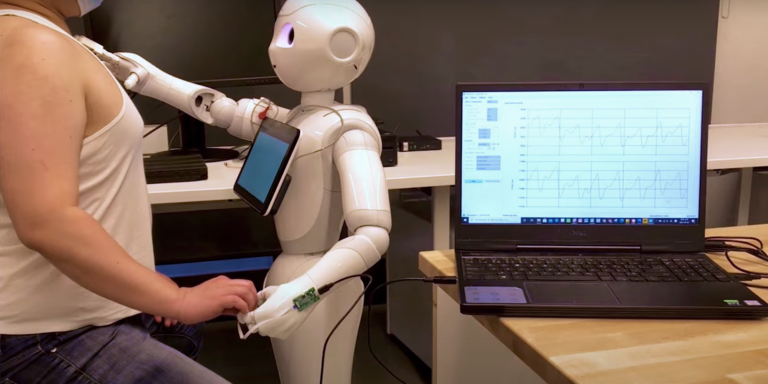
A team from Simon Fraser University in British Columbia, Canada, led by Woo Soo Kim has announced its latest healthcare technology development that allows miniature humanoid sensing robots to take a patient’s blood pressure with a simple touch. The study, published in the journal Nature, is titled “3D-printed leech-inspired origami dry electrodes for electrophysiology sensing robots.”
Blood pressure is an essential diagnostic tool in health care. Hypertension, a pre-existing symptom or precursor to possible infection in patients, is the number one driver of cardiovascular disease. Patients with high blood pressure can monitor their own blood pressure with blood pressure cuffs, but this cannot be done continuously.
Tae Ho Kim, Chao Bao, Ziniu Chen, Woo Soo Kim of Simon Fraser University conducted a study on robotic blood pressure systems that would allow remote monitoring of remote or isolated patients in the event of pandemics.
Intelligent dry electrodes inspired by origami and leeches
The research team invented a new way to measure blood pressure. They were inspired by origami and the suction mechanism of leeches to develop a dry electrode that allows reliable blood pressure monitoring. The leech-inspired suction mechanism generated a local soft vacuum facilitating appropriate contact with human skin. Subsequently, an electrocardiogram (ECG) sensor, called a leech-inspired origami (LIO) sensor, was constructed using the developed dry electrode. These 3D printable origami sensors are embedded in the fingers of a humanoid sensing robot. Tae-Ho Kim explains:
“Our origami-inspired dry electrode has unique features. It sucks as a grip and can bend, in mechanisms inspired by nature. Consistent with nature, we have seen that in addition to the complex mechanisms of a leech’s adhesive function, these creatures have an expandable suction cup and hind body, while its organs expand and shrink appropriately to maintain a better grip on its victim. Incorporating this view, we then found that origami could perform similar movements.”
Measuring blood pressure
The robot’s fingers must be positioned on the patient’s chest. Blood pressure is monitored by combining data from electrocardiogram (ECG) and photoplethysmogram (PPG) readings, recorded by the integrated IOL sensors, respectively. Thus, with the specially designed algorithms, the signals from the paired sensors can generate a patient’s systolic and diastolic blood pressure without using the digital cuff sphygmomanometer.
Prior to this study, Tae Ho Kim conducted research on other sensing robots to measure various human physiological signals, such as heart activity, temperature, and respiratory rate. He states:
“Robotics offers a promising method to mitigate risks and improve the efficiency and quality of patient care. This was about us applying it as a targeted remote health care technology.”
The team still needs to work on this new technology and refine it so that it results in a new generation of sensors.
Article source: Kim, TH., Bao, C., Chen, Z. et al. 3D printed leech-inspired origami dry electrodes for electrophysiology sensing robots. npj Flex Electron 6, 5 (2022). https://doi.org/10.1038/s41528-022-00139
Translated from Canada : Une équipe de l’Université Simon Fraser met au point des robots humanoïdes miniatures pour mesurer la tension artérielle









